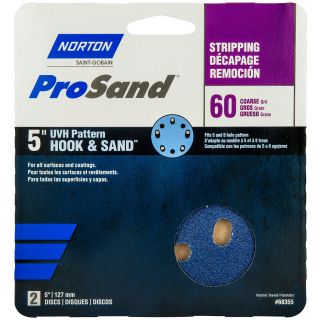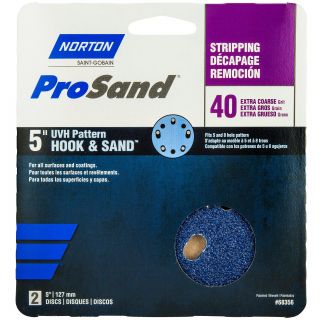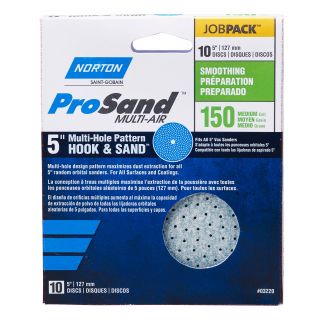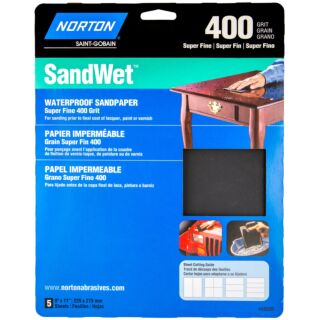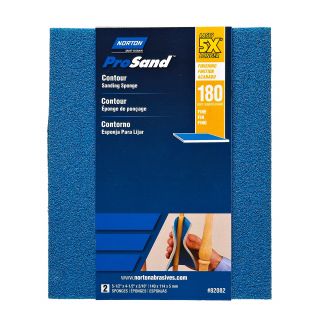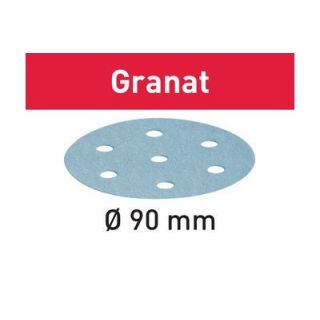Sandpaper & Sanding Tools
-
 Norton 6 in. ProSand Hook & Sand Random Orbital Discs 150 Grit, Multi Hole, 10 Pack SKU: NOR05322$25.49
Norton 6 in. ProSand Hook & Sand Random Orbital Discs 150 Grit, Multi Hole, 10 Pack SKU: NOR05322$25.49
Sanding Tools
If you're doing any sort of woodworking or painting, you'll come to find that sanding is absolutely crucial. Depending on how large the job that you're doing is, you may need more than just a sheet of sandpaper. Luckily, there are a variety of different sanding tools available to you on the market!
Sanding tools are any tools that help you with sanding surfaces. They can be used for surface removal and paint preparation or used to shape pieces of wood. No matter the reason, it's important to know about all the different options available when it comes to sanding tools.
Sandpaper and What You Should Look For
When you're tackling a sanding project, you'll need to know a bit about sandpaper and its grit. Knowing what type of sandpaper you'll need is key to using any sanding tools, as well as completing any sanding job the proper way.
Sandpaper grit can range from being very coarse to extremely fine, with the finest grits being used for wet sanding of paints and metals, giving them mirror like finishes. The below grit ranges are typical of most sandpaper available on the market, and what they're typically used for.
-
60 Grit - Coarse - Used for quick removal of rough material or paints
-
80 Grit - Coarse - Used to remove stain and prepare surfaces for the first step of finishing
-
100 Grit - Medium - Used for leveling surfaces
-
150 Grit - Medium - Used to smooth an already leveled surface
-
180 Grit - Fine - Used for fine sanding and detailing before the application of paint, stain, varnish, or sealers
-
240 Grit - Fine - Used to sand between coats of paint, sealer, stain, or varnish
-
320 Grit - Fine - Used to touch up areas on sealed or painted materials
-
Greater Than 320 Grit - Extra Fine - Used mostly for metals and paints when trying to achieve a mirror-like finish
For most projects you'll need an array of grits. Many multi-packs are available that will give you several sheets of multiple grits, allowing a customer to purchase one package of sandpaper rather than several.
Manual Sanders
Manual sanders are used to increase the speed of the sanding work being done. They aren't very complicated, but they make the work much easier, and really let you smooth out the grain without putting in as much work as you would by hand.
Hand Sander
Hand sanders come in many different shapes and sizes. They can be blocks, or can be a specific contour to make shaping a much simpler task. Hand sanders are designed to let users attach sandpaper to the block using clips or Velcro, depending on the application.
Pole Sander
The pole sander is a sanding tool similar to the hand sander, but placed on a pole to extend its reach. These tools are normally used in drywall applications to smooth out rough surfaces after the material has been hung. They almost always use a square pad, or a rectangular pad, allowing them to fit into corners.
Electric Sanders
Electric sanders, also known as power sanders, are ideal for larger surfaces and help you remove material in a very quick manner. Many woodworkers have several of these machines in their workshops.
Orbital Sander
The orbital sander, also known as the palm sander, is a handheld power sander that most people can get use out of. Orbital sanders are a fantastic option for people looking for an aggressive sander that are precise and affordable. They normally come with a square pad, where other sanders come with round pads. These are some of the best sanders for beginning woodworkers and professionals.
When looking for an orbital sander, you'll normally have the option to by a cordless sander, or one that's got a cord. The corded versions are normally more powerful than the cordless power tools. Many of these also allow for dust collection, as well.
Random Orbital Sander
Random orbital sanders are like orbital sanders, but come with a circular pad rather than a square pad. If you're looking for a counterpart to go along with a regular orbital sander, consider picking up one of these power tools. They are known for leaving behind less swirl marks than an orbital sander does, as their random orbit prevents an entirely circular motion from occurring. That random motion is key in the operation of the power tool.
Belt Sander
Belt sanders are another common type of electric sander that you'll find in many homes. The design of a belt sander is simple; a sand paper belt fits over two drums and is rotated, like the belts of a car. A high-quality belt sander will have variable speed control, and will allow for belts of different sizes and grit to be used in conjunction with it. When you're looking for a power sander meant for sanding heavy workloads, a belt sander is what you need.
These sanders are best used to remove large amounts of paint and varnish from the surface of wood. If you're looking to refinish furniture or, like tables, cabinets, or chairs, you'll need a belt sander in your home.
Floor Drum Sander
While a floor drum sander isn't the best option for tight spots on the floor, it's ideal for stripping anything off of wood floors in no time. They can remove adhesive, paint, or varnish with ease. They're very heavy pieces of machinery, and often require two people to move from site to site. To use this sander, you'll need to have a tight grip. They're very powerful, and the heavy vibration that you'll feel while using a floor drum sander is sure to test your grip strength.
Detail Sander
Detail sanders are a small power tool, and they fit into tight spots very easily. They are similar in size to the palm sander mentioned prior, and are fairly easy to handle. If you're looking for a sanding tool that's able to tackle small pieces of furniture or wood, you'll want a detail sander. Most detail sanders have a specific shape, requiring the customer to buy a specific sanding pad for them. They're best used on edges and corners, and can help you smooth out scratches. These lightweight power sanders are useful when you need a lot of control while sanding.
Table Sander
Table sanders are often referred to as bench sanders. These are best used for sanding objects quickly, but aren't ideal for any sort of precision woodwork. The average table sander is quite a large machine, and as such has industrial applications, normally. For at home use, belt sanders will need to be housed in a workshop as they can't be moved around too easily. Because of their large application and powerful operation, you'll also want to put together a means of dust collection when you purchase one.
Edging Sander
Edging sanders are another type of floor sander. They're smaller than a floor drum sander, and they're able to tackle spots that a drum sander can't. These sanders are powerful, just like their larger counter parts, and as such need to be used carefully. Both drum and edging sanders have the ability to damage hardwood floors if used incorrectly. This electric sander almost always comes with a means of dust collection attached to it. This can be a bag, or a hose attachment for a vacuum. When refinishing floors, it's best to keep the dust and required cleanup to a minimum. Dust control is essential for all jobs requiring sanding, but it's far more important when it comes to floors.
Disc Sander
A disc sander is another larger sander that is a bit easier to operate than a table sander. They're comprised of a large wheel attached to a motor, and the wheel allows you to attach different grits of sand paper. They can be handheld, or can be attached to a table for more permanent applications. Because of the ability to place them as a fixture or use them as a standalone machine, these sanders are excellent in terms of versatility and control. They can be set up in a way that suits whatever process you are currently pursuing. In addition to smoothing surfaces, disc sanders can be used to remove buildup of corrosion on metal as well, as long as they're used in a safe manner.
Drywall Sander
Like pole sanders, drywall sanders are best used in sanding applications specifically for hanging drywall. Many adhesives are used in the process of hanging drywall, and this sander makes it easy to remove them all prior to applying paint to the walls. Many of these tools allow for a dust collector to be attached, making cleanup much easier afterwards. If you're hanging drywall, you'll need a drywall sander.
Other Tools and Protective Equipment You May Need
If you are doing a lot of sanding, chances are you'll need other tools to get the job you're doing done. You'll also surely need protective equipment, as sanding can expose you to harmful materials or chemicals in certain situations. Check out the following tools and equipment that can make your life easier and keep you healthier.
Dust Mask
The first piece of protective equipment that you'll need is a dust mask. These are absolutely essential when you're sanding wood, or removing finishes from wood. When you sand, particulates are released into the air that can be inhaled through the nose and mouth. When some of these substances enter your body, they can cause harm. Some older paints have lead in them, while many varnishes and sealers can be toxic when inhaled as well. Not to mention the possibility of inhaling wood dust and causing abrasions in your airways. Be sure to wear a dust mask properly when sanding.
Eye Protection
Sanding, especially when using a power tool to assist the process, can kick up more than just dust. Occasionally, larger pieces of wood or metal can be flung from the object you're sanding. If you're not wearing eye protection, this may cause eye injuries, and can permanently impair your vision. Be sure to pick up a set of safety glasses or safety goggles when you expect to sand anything.
Shop Vacuum
A durable shop vacuum is an invaluable tool for cleanup following sanding. With dust and particulates being thrown into the air from the sander, surfaces will quickly be covered in grit and grime. A shop vacuum makes light work of cleaning up. Additionally, they can normally be converted into a dust collection system with ease. Many tools come with attachment points for vacuum hoses, helping to prevent the mess that a shop vac would typically be used to clean up. If you're doing a lot of woodworking, pick up a shop vac as well; you won't regret it.
Tack Cloth
Ideally, you'll be cleaning the surface of whatever you're sanding in between different grits of sandpaper. The best product to use for this is tack cloth. Tack cloth helps to remove all dust and extra particles from the surface that you're sanding, which allows for the cleanest application of paints, varnishes, sealers, and oils. Removing all unnecessary dust is essential in adhesion of these products to whatever surface you may be working on.
Frequently Asked Questions About Sanding
How do I sand wood?
Sanding wood should be done with the grain of the wood. If the wood grain is covered by paint, sand a small area down until the grain is exposed. Sanding with the grain helps to prevent any unnecessary material destruction, and allows for the smoothest finish possible.
If I'm sanding wood, what grits will I need?
This is entirely dependent upon the level of material removal that's needed. Generally, you'll want to have grits ranging from 60 to 180 at a minimum. However, if you are looking to produce a mirror-like finish or shine, you'll need to purchase finer grit sandpaper to achieve the look you're after.
Is an electric sander necessary?
In short, no. Using elbow grease and sheets of sandpaper on a block or similar tool can achieve the sanding results you're looking for. However, it may take some time to achieve that look. Some manual sanding projects may take hours where the use of a random orbital sander or belt sander can turn that into minutes.
What are the best sanders?
For most applications, a random orbital sander will be the best sander for an individual. They allow for quick removal of surface debris and rough edges. Other sanders will seem too specialized whereas a random orbital sander will be able to be used in many applications. They're also a bit easier to use than a standard orbital sander.
What do I need to refinish furniture?
If you're looking to refinish wood furniture, you'll need a few essential supplies. Of course, you'll need a sander and sandpaper in various grits, protection for your respiratory system and eyes, tack cloth, and a vacuum. These are what you'll need to get the surfaces of wood furniture ready for refinishing. Then, you'll want to pick up whatever you plan on finishing the wood with, be it oil, paint, varnish, or another material. A tarp is useful for putting under the project when applying any liquid finishes.

